



Forests are - in terms of biomass accumulation and stability - the most successful ecosystems in the world. Natural forest ecosystems offer multiple ecosystem services, such as timber and fuel wood provision, water purification, carbon sequestration. In mountainous landscapes, forests have an additional protective function against erosion and natural hazards (e.g., avalanches, landslides, debris flows or rock falls). In the South Caucasus, two natural limits restrict forest expansion: at 2.300-2.600m a.s.l. the upper tree line is visible, whereas steppe and semi-desert ecosystems form the lower tree line.
Socio-economic and geo-physical living conditions:
The intervention area is located at the northern to eastern slopes of Mount Aragats (4013m). The villages are located at 1600 to 1800 m above sea level where the slope meets a plain with stepic soils and crop production while the slopes of the mountains are used for livestock grazing (sheep and cattle).
Purpose of afforestation:
By means of afforestation of degraded pastures, mountainous areas that suffer from erosion and overgrazing should be rehabilitated and erosion protection capacity enhanced. At the same time, the afforestation sites should form the basis for future community forests providing a wide range of ecosystem services, a concept that has not yet been established in Armenia.
Implementation
Between 2014 and 2017 more than 200 hectares were fenced for afforestation, 145 ha were actively afforested in 10 different communities around Mount Aragats in Armenia. The average size of the 20 plots is 10 ha (35 ha being the largest site, 1 ha the smallest one).
The afforestation included different species combinations, planting schemes and methods to determine most cost-efficient afforestation methods for Armenian conditions. All afforestation took place at elevations between 1900 and 2300 m.a.s.l.. The afforestation included fencing of the area to protect the afforestation site against grazing, the preparation of the planting sites according to fixed planting schemes, the actual planting in lines with trenches, single plant holes and group plantings. For some sites, additional irrigation was established for the first years. Particular attention was paid to the species selection which explicitly included fruit trees and shrubs to ensure local economic returns.
Practical experiences
A wide range species was tested. Within the given climate context, pine (Pinus sylvestris), the main non-native species as well as native maple (Acer trautvetteri), Persian Oak (Quercus macranthera) and birch (Betula litwinowii) showed the best results. Particular attention was paid to adapted species to create resilient forest-shrubland with a large number of tree species. In general, planting in trenches shows highest survival rates. Bare root system and containerized seedlings were used for planting. Containerized seedlings definitely provide better survival rate in comparison with bare root system seedlings. Additionally, mulch cover was provided to protect seedlings and keep soil humidity. The main maintenance measures are repeated mulching and weed control and irrigation during the first 3 years. Furthermore, some replanting is continuously taking place as the sites are facing tough environmental conditions (hot summers, drought, short vegetation period).
The plantation was organised and supervised by local NGO's (ATP Armenian Tree Project, ESAC Environmental Sustainability Assistance Center) in close cooperation with the local village population. In a Memorandum of Understandig between the Armenian Ministry of Territorial Administration and Development, the local village administration and GIZ the share of payed labour and own contribution was fixed beforehand.
Impacts and perception
After the first years already first successes are becoming visible contributing to increased vegetation cover, increased biomass and improved soil protection. The communities are proud to be amongst the first in Armenia with a community forest. However, slow growth will require continuous commitment and care on behalf of the community.
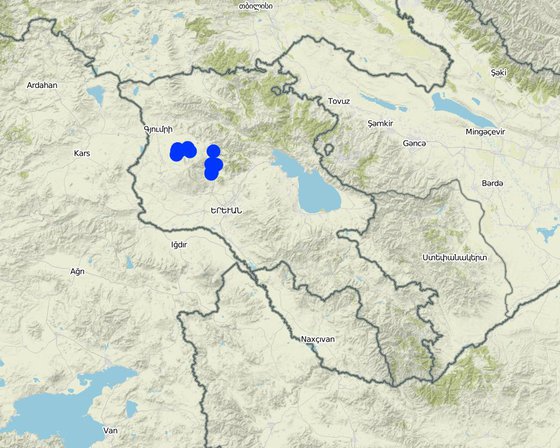
Localização: Lusagyugh, Saralanj, Harich, Arayi, Quchak, Hnaberd, Mets Manatash, Pokr Mantash, Nahapetavan, Shirak and Aragatsotn Marzes, Armênia
Nº de sites de tecnologia analisados: 10-100 locais
Difusão da tecnologia: Uniformemente difundida numa área (approx. < 0,1 km2 (10 ha))
Data da implementação: menos de 10 anos atrás (recentemente)
Tipo de introdução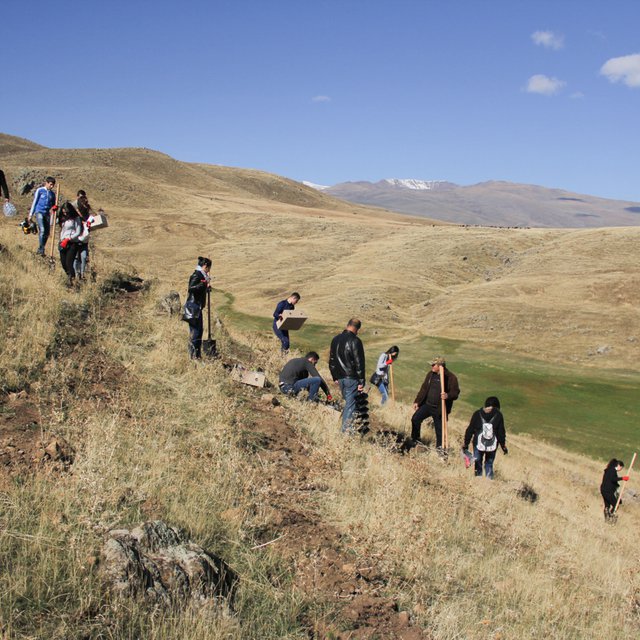
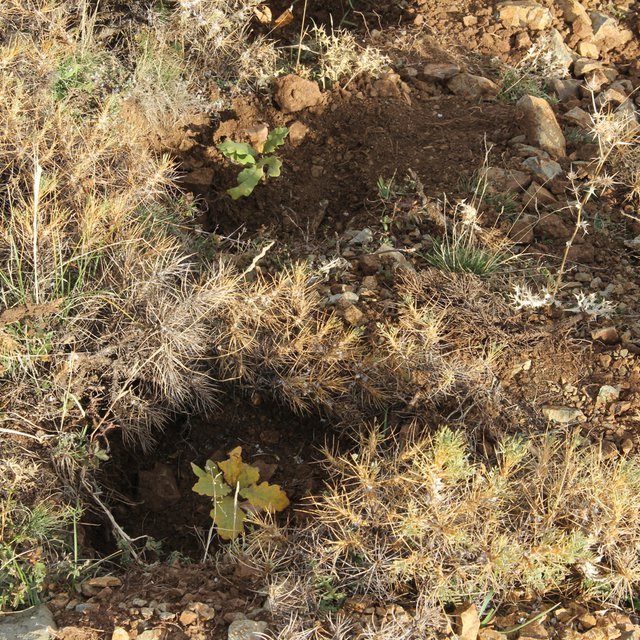






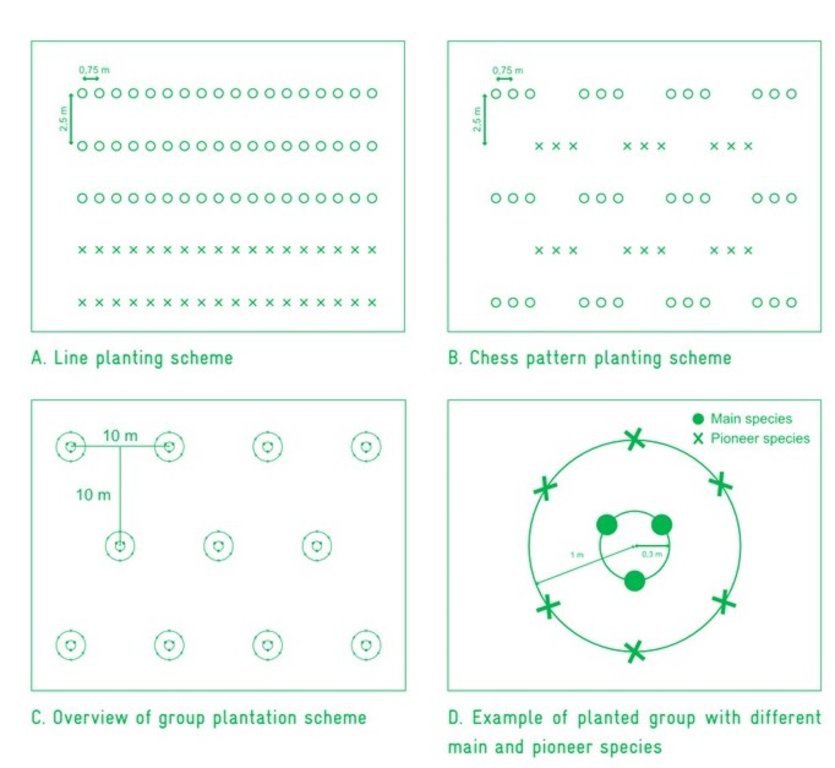

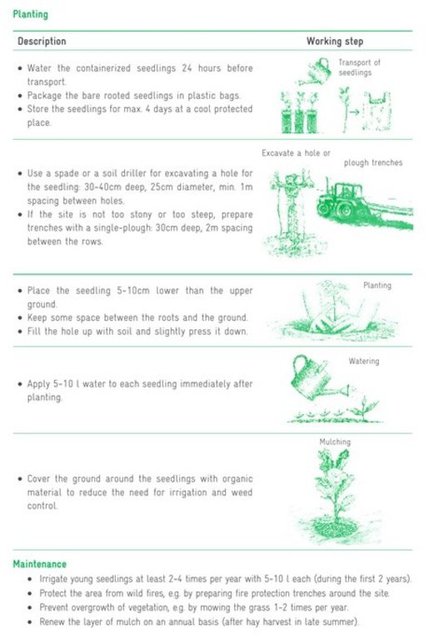
| Especifique a entrada | Unidade | Quantidade | Custos por unidade (Dólares norte-americanos) | Custos totais por entrada (Dólares norte-americanos) | % dos custos arcados pelos usuários da terra |
| Mão-de-obra | |||||
| Local workers for plantation of trees | seedlings | 2500,0 | 0,27 | 675,0 | 10,0 |
| Installation of fence and posts | person day | 191,0 | 12,3 | 2349,3 | |
| Equipamento | |||||
| Equipment (hummer, driller, etc.) | set | 1,0 | 141,8 | 141,8 | 30,0 |
| Material vegetal | |||||
| Tree seedlings | pieces | 2500,0 | 0,31 | 775,0 | |
| Mulching | kg | 1250,0 | 0,03 | 37,5 | |
| Material de construção | |||||
| Fencing (permanent mesh wire fence) | meter | 317,0 | 1,35 | 427,95 | 10,0 |
| Irrigation system | set | 1,0 | 889,0 | 889,0 | 15,0 |
| Metal posts for fence (1.8m) | pieces | 106,0 | 2,97 | 314,82 | |
| sand | kg | 3444,0 | 0,012 | 41,33 | |
| Other material(electrode, wire armature, metal disc) | set | 1,0 | 386,9 | 386,9 | 20,0 |
| Cement | kg | 1148,0 | 0,12 | 137,76 | |
| Outros | |||||
| Transporation of mulch | time | 1,0 | 102,8 | 102,8 | |
| Transporation of construction materials | time | 5,0 | 92,5 | 462,5 | |
| Transporation of workers to the field | time | 15,0 | 30,2 | 453,0 | |
| Transporation of seedlings | time | 1,0 | 51,4 | 51,4 | |
| Custos totais para a implantação da tecnologia | 7'246.06 | ||||
| Especifique a entrada | Unidade | Quantidade | Custos por unidade (Dólares norte-americanos) | Custos totais por entrada (Dólares norte-americanos) | % dos custos arcados pelos usuários da terra |
| Mão-de-obra | |||||
| Irrigation of young seedlings with 5-10 l | Man/day | 1,0 | 10,0 | 10,0 | 100,0 |
| Preparation of fire protection trenches | rm | 150,0 | 0,34 | 51,0 | 100,0 |
| Mowing to prevent overgrowth of seedlings | Man/day | 4,0 | 10,0 | 40,0 | 50,0 |
| Renew mulch layer (including mulch value) | Man/day | 5,0 | 10,0 | 50,0 | 50,0 |
| Material vegetal | |||||
| Seedlings for replantation (including labour) | seedlings | 1200,0 | 0,51 | 612,0 | 50,0 |
| Outros | |||||
| Petrol for irrigation | liter | 7,0 | 0,8 | 5,6 | |
| Custos totais para a manutenção da tecnologia | 768.6 | ||||
Within the fenced afforestation site, the grass could be cut and used as hay. The protection from grazing helps biomass development which leads to better protection from Surface water Erosion and this lead to soil-regeneration and increase of productivity.
The natural forest was removed for the purpose of grazing and the forest cover will be now re-established on the afforestation sites.
We mixed shrub species like raspberries and fruit-trees (wilde plumb) between the main tree species to create short time Benefit for the village people.
In addition to the wide spread grazing land use now the hay production in the fenced afforestation site is increased for the first 1-2 decades (until the canopy is too dense) and the collection of berries and fruits give additional income opportunities. In the Long terme fuel wood production can be expected from the forested land.
The grazing range is limited by the fenced afforestation site. This is relevant in the first couple of years before hay or fruit/berry productivity is able to fully compensate the loss of grazing range.
The maintenance of the afforestation site lead to increase of workload especially in the first 2-4 years when hay cutting and Irrigation is needed until the tree seedlings are well established.
As there is almost no forest near to the villages every woodland is very attractive for recreational purpose, but it will Need 2-3 decades until this function will be fulfilled by the afforestation site.
The local stakeholders got hands on training on fencing, afforestation and maintenance of afforestation sites.
The fencing of the afforestation site immediately stops the heavy grazing Impact which leads to fast recovery of the Vegetation. The improved Vegetation cover and better development of the root System reduce Surface water run of Speed and increase water Infiltration.
An increase of vegetation and the leaf area index will lead to an increase of evaporation.
Increase of vegetation cover and reduction of water runoff will lead to decrease of soil loss.
The increase of vegetation leads to an increase of root development. Additionally, the increase of vegetation produces more litter, as no grazing is applied. The increase in litter leads to an increase of an humus layer and therefore to more below ground carbon.
Especially the fencing leads to fast increase of vegetation cover.
The local stakeholders got hands on training on fencing, afforestation and maintenance of afforestation sites.
The stop of grazing and the new micro-habitats created by the shadow of the tree seedlings have let to an increase in plant diversity. This process might be reverse when the tree canopy is closed and less light is available for the herb-layer, but this will take several decades.
The plain grasslands habitats are diversified by patches of forest.
The decrease of water run off increase the water capacity of the habitat and the afforested area will provide increase buffer capacity in the case of intensive rainfalls.
The high grass and trees reduce wind speed at ground level.